Oh, Spoleto. You are a beautiful city, one of the great hill towns of Italy, located in the region of Umbria in the center of the country.
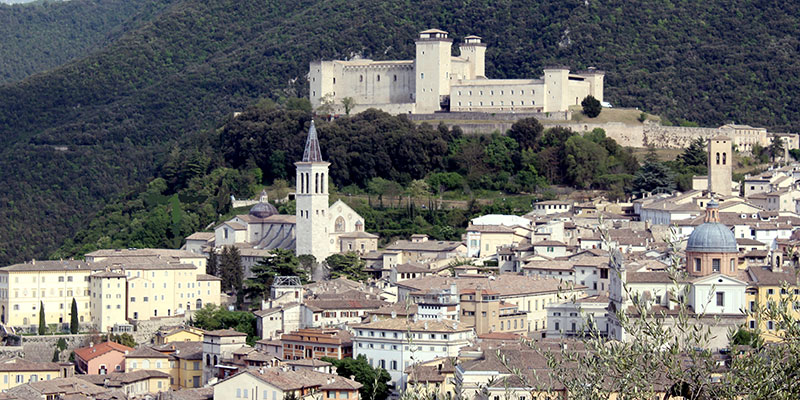
If it's on a hill, there must be steps, and yes, there are many steps in Spoleto, and little lanes in the pedestrian zone at the heart of town. In a nutshell, there is an upper town, lower town, famous cathedral, and a fortress with aqueduct bridge. The city has created an amazing free system of three long escalators that will take you up the hill, with various exits along the way at different piazzas and landmarks, making your explorations so much easier.
There is a big story to tell in this long web page, which describes an efficient walking route taking you to all the important places without getting lost or wasting time at minor sights. It is worthwhile reading the page from start to finish to follow the route, but it is divided into three sections so that you could jump around. Spooleto has one of the largest historic centers in Italy, so it takes a while to properly explain it.
We will take you on a walking tour through the delightful historic center, which you can experience during the daytime and after dark when the town comes out for its evening stroll for the classic Italian passeggiata. The pedestrian town center has a special character, with inviting lanes and alluring medieval alleys. This is a very safe place to be, for visitors and locals alike. From the Roman period to the present day, the charm of Spoleto history has seduced visitors through the ages. With an excellent state of preservation, the old town is not very different from what it looked like to the 18th and 19th-century travelers.
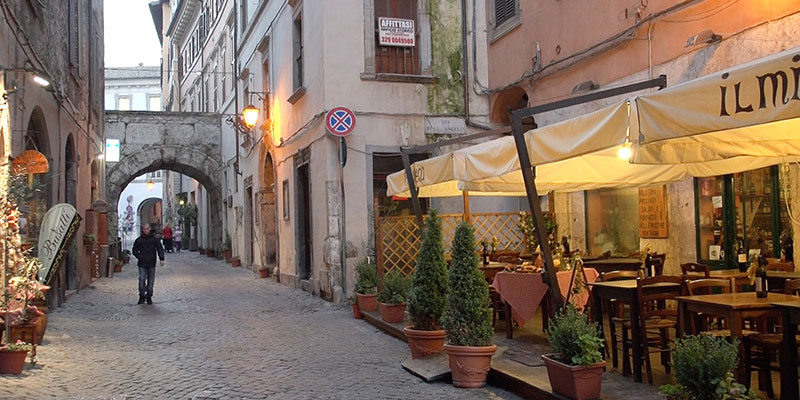
The old town is about one square kilometer, so it's a very manageable size where everything is in walking distance, with many shops, restaurants, museums, a fortress, the cathedral, and old palaces. It makes a great place for exploring on foot, filled with little lanes, staircases, historic buildings, piazzas, and vistas, with numerous shops, cafes and restaurants to keep you going.
Most people are familiar with Tuscany, with its famous capital of Florence, and while Umbria is less well-known, it's every bit as beautiful as Tuscany. So that is quite nice and refreshing in this day and age of over-tourism, where popular cities get super-crowded. Busy places in central Italy area are wonderful places to see, but other towns, like Spoleto, which are also really quite attractive and a fine destination to visit, just are not crowded with tourists.
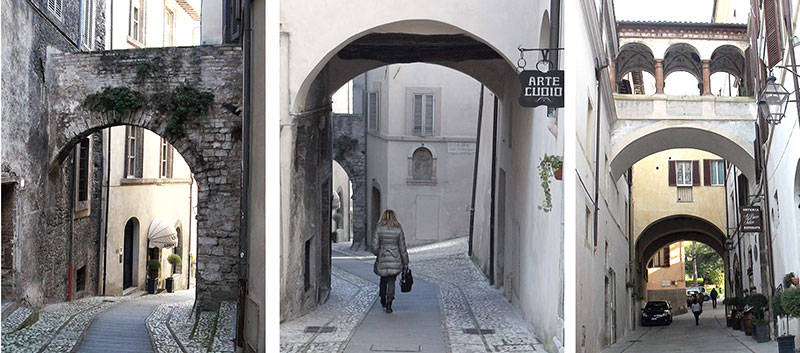
Spoleto makes a good base for touring other nearby Umbrian towns, such as Spello, a 30-minute train ride away. Umbria has many of these small, beautifully preserved, historic towns just waiting for you to visit. And they are not crowded because they're not so well-known as many of the cities of Tuscany.
It was amazing to enjoy such a beautiful location in peace and tranquility, especially calm during the off-season, such as my visit in November. The weather was great, a little cool, but you put on a sweater or jacket and you're going to be just fine. Curiously, it can get a little foggy at this time of year in the fall and in the winter, which can be quite nice. It provides the added element of atmosphere and usually it quickly blows away. These cool temperatures make it easy to do lots of walking.
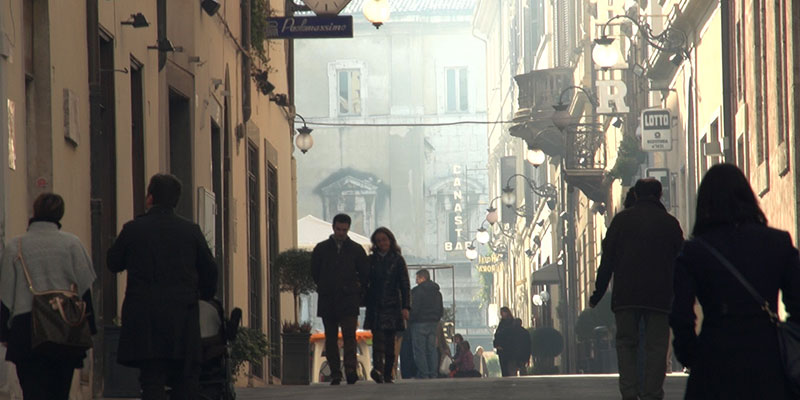
Spoleto is world-famous because of the music Festival of Two Worlds, founded here by Gian Carlo Menotti in 1958, and still performed every year in late June/early July. But you will see there is so much more to this town than a music festival.
Spoleto is easy to reach because it's located on a main train line, and there is a public bus that can bring you from the station up to the old town for a modest fee, or you could take a taxi. For those driving here in a car, there are three municipal parking lots just outside the old town with escalators from each that will bring you into the center, including one that goes all the way up to the fortress on the hill. All-day parking is currently 10 euro. Depending on which of the three parking lots you choose, you can begin your visit at the cathedral, or the fortress, or at Piazza della Libertà (as we suggest).
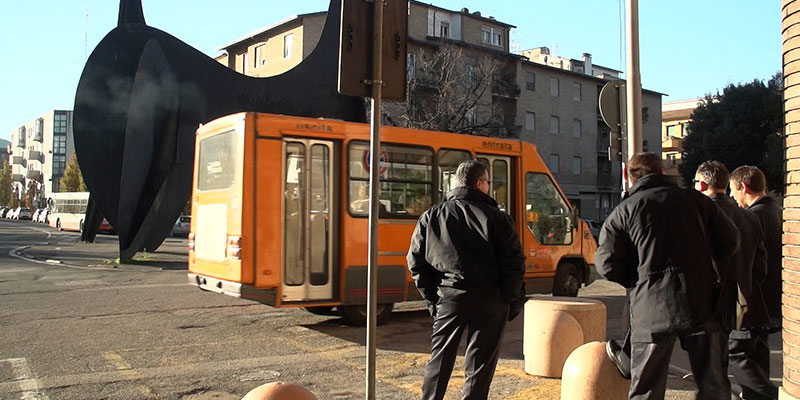
If arriving by train, there are shuttle buses in front of the train station that will take you to the old town, all the way to Piazza della Libertà. Notice the huge black metal sculpture in front of the station, a monumental stabile by Alexander Calder.
It's about a kilometer walk to the old town, so it's better to take the bus, especially if you have a suitcase, and let the driver do all the work. Walking takes about ten or fifteen minutes, so that's a reasonable walk, but it is not terribly interesting, passing some bland modern buildings along the way. Stick with the bus, or you could take a taxi, which would be especially good if you're staying at a small hotel in the middle of the old town, where the buses don't go.
The bus stops at Piazza Della Vittoria, the main gateway leading you into the old town, but stay on board until you reach Piazza della Libertà, a good place to begin because now you're on the edge of the old town, ready to explore. If you are driving, there is a parking lot down below for automobiles connected up by escalators.
We're going to walk around and around – it’s a bit of a maze in these old streets, like a big bowl of spaghetti. You could just wander freely at will, or follow a certain path so that you can see all the main sites, as we're going to show you. It is a challenge to provide a single coherent route through these many lanes for you to follow in a one-day visit, but we will do that for you here, based on one streamlined route, while including some added detours for those wanting more.
The walking route we have planned for you has a baseline distance of 5 kilometers, but you need to add in those meandering side legs, inside various museums, shops, piazzas and then consider that some of it goes uphill. This is an ambitious itinerary that could be done in one full day, but you will see there is so much coming up that a couple of days would make a more comfortable visit.
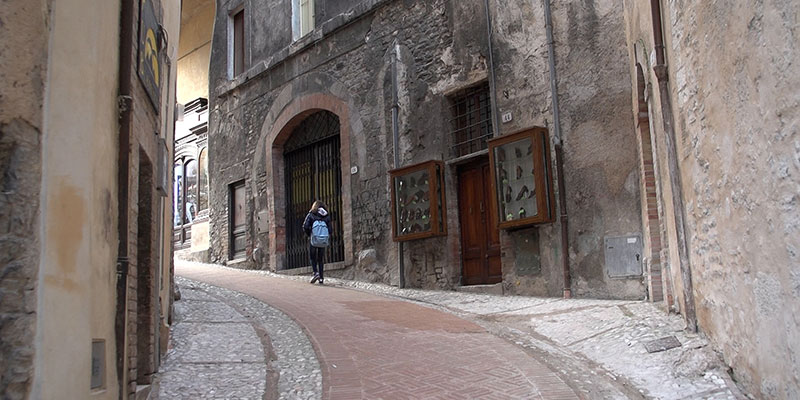
Because of the convoluted curves of the streets, and different interests and time constraints of the visitor, there is no one single best way for everybody to proceed, but we will help you navigate for best results. It would be ideal if you had several days here to wander at will and soak up this superb atmosphere, wandering along random side alleys here and there.
Many lanes are quite beautiful, lined with old buildings, cobbled paving, little piazzas, fountains and cafes, but others are boring, wasting your energy for nothing. There is a mix of pedestrians lanes and others that allow some cars, but those are still easy to walk on. Night and day take on a different atmospheres, so it's great to spend a night or two and have enough time to be able to walk around both daytime and in the evening.
Our route begins on Corso Giuseppe Mazzini, which assumes you either drove and parked your car at the Spotletpsfera public lot on the east side and rode the escalator up, or that you arrived by train and took the city bus to its stop on the adjacent Piazza della Liberta.
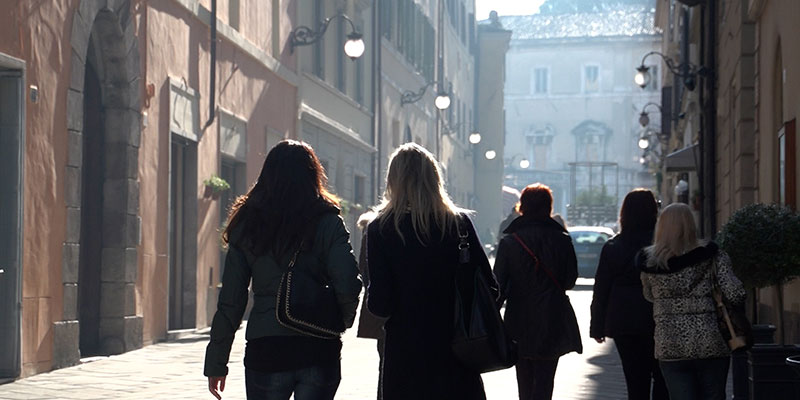
Corso Mazzini extends out from that piazza and is one of the city's main streets, which could be easily overlooked if you don’t start here. It's a broad pedestrian promenade lined with shops, hotels and restaurants, with alluring side streets. I enjoyed staying at the Aurora Hotel, along the beginning of this street.
Corso Mazzini is quite different from many old town streets because it is wide and straight, while most other streets are narrow and curved, dating back centuries. Corso Mazzini was created in the mid-19th century in an effort to make the old town more accessible. It's also delightful to stroll in the evening when locals are out shopping, talking, enjoying their stroll – the passeggiata.
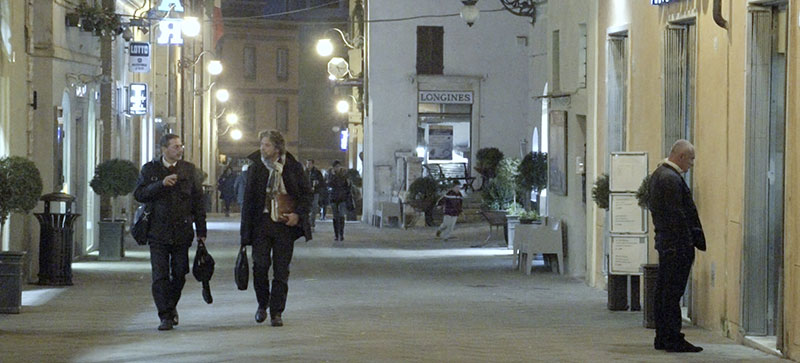
The street is named after Giuseppe Mazzini, who was one of the heroes and leaders of the Italian struggle for unification in the mid-19th century. He was one of the founders of the first organized political party in the history of Italy.
There is one other street in the old town that is similarly straight and wide, named after another hero of the independence movement, Garibaldi, which you’ll see later when we get to the lower town. The street is just about 250 meters long, so it's quite easy to stroll the entire length, and you might want to walk back and forth.
Corso Mazzini leads to the archaeological museum, with extensive Roman remains, including the ancient theater built in the first century BC.
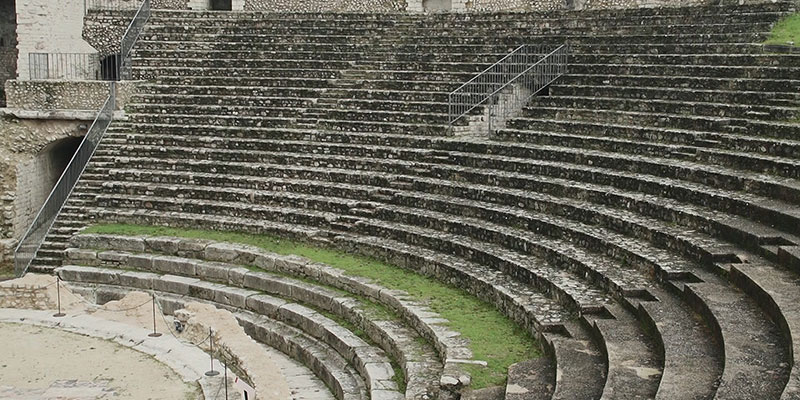
The State Archaeological Museum has a number of finds that were discovered with the excavations in and around Spoleto and the region, including statues, busts, inscriptions, vases, household items, tombstones with carved script identifying the date and person buried.
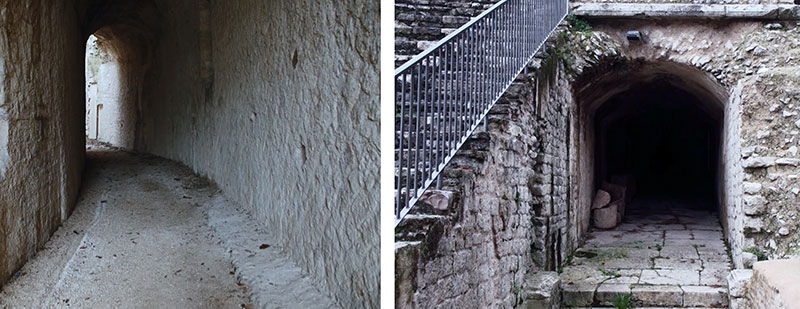
It is located next to an ancient Roman theater, where you can walk through arcades and tunnel passageways. It's almost like stepping back into ancient Rome itself, with this is immersive experience, included with your price of admission. The flat semicircular area in front was the orchestra with premier seats, with some of the original polychrome marble floor still preserved.
The Romans used the theater until the 4th century, and then in the early Middle Ages it was converted into a jail and then later, was taken over by the Benedictine nuns and became part of the monastery's cloister. Rediscovered in 1891, it was brought back to life through archaeological excavations between 1954 and 1960. The theater is still used for performances and plays today, thanks to renovations and stabilizing work.
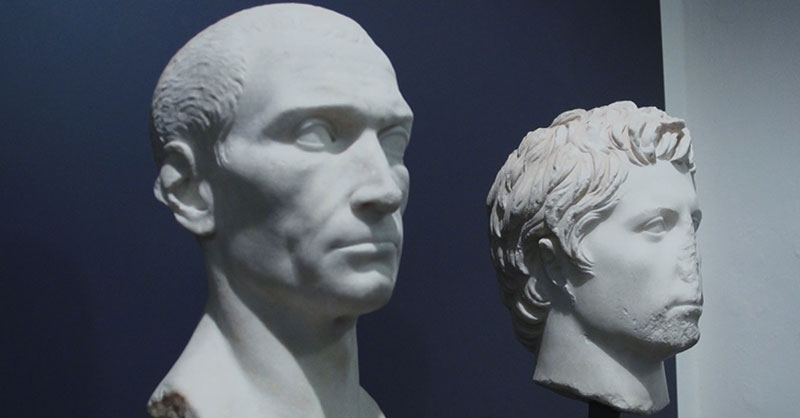
The exhibits are in several rooms with hundreds of items, including architectural fragments and lots of pottery, the basic vessel of storage and cooking. Among other ancient tools, there is a loom showing how they wove fabric. Display boards and labels help you understand what you're looking at.
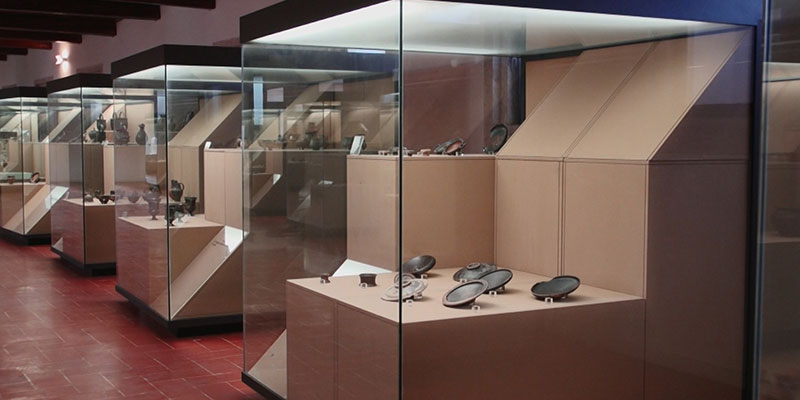
Continuing along Corso Mazzini, turn left down Plinio il Giovane, a charming pedestrian lane with arches, shops and many old buildings. You’ll reach the intersection with Via delle Terme, which changes names here to Via Giustolo. Here you’ll see a small church that has been converted to an intimate, 78-seat, cinema showhouse, Cinema Sala Pegasus.
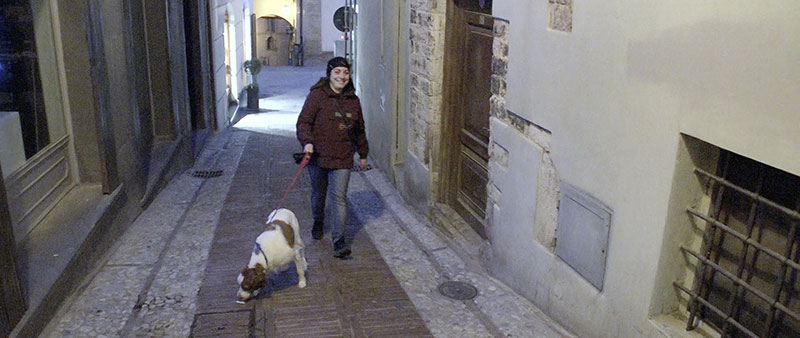
Some of these streets are pedestrian-only, while others are a mix with cars and little buses that come whizzing through, driving under the old medieval archways. There are no sidewalks on these little streets, but it's still quite safe for pedestrians. Down at the end of Plinio il Giovane you might kick back for a drink or meal at Caffè Collicola, on a small piazza of that name.
Rather than continuing further into less interesting streets, turn around and return along the same route back up Plinio il Giovane, one of the main streets of town. Now and then a little backtracking can be useful to stay on the most interesting routes, and avoid getting lost of wasting time. Walking a different direction on the same street can provide new perspectives. Plinio il Giovane changes name to Via Del Mercato, leading to the main piazza of town.
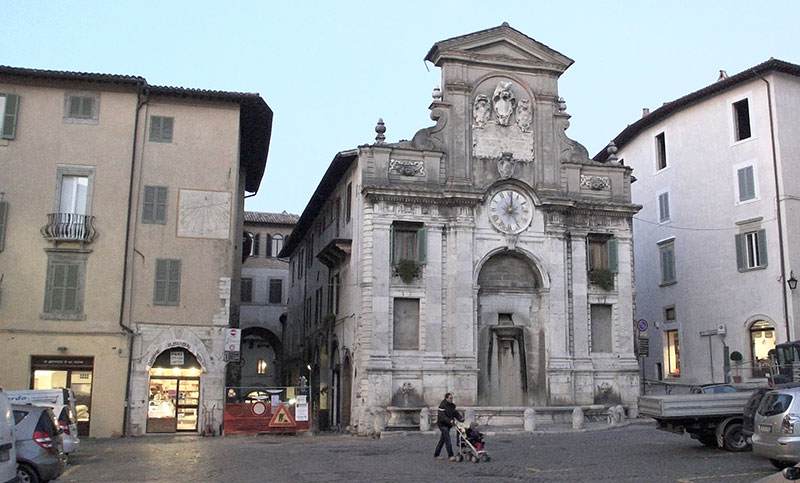
This piazza has been the center of town for more than 2000 years. The Romans established their settlement here in the year 241 BC, and this was the main central square of those ancient Romans. It was their forum, surrounded by temples and palaces and lively activity like shopping, eating and drinking, similar to what is still going on today.
It might look like a Baroque church at the north end of the forum, but take a closer look up on the side balcony and you'll see some laundry hanging out and people living upstairs. There had been a Romanesque church of San Donato on this site, but it fell down in the end of the 16th century.
There is a monument to the powerful Barberini family from Rome on the wall of this structure. You can see carvings of bees up on the façade, the symbol of the Barberinis, all designed by Carlo Maderno in 1626. There is an impressive old clock face on the building, and beneath it a fountain, dating to 1746, which replaced an earlier one built in 1433.
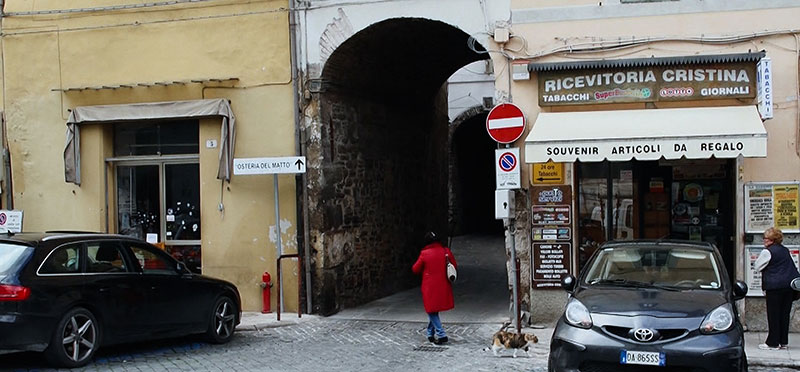
Sometimes the market square is so quiet that it gets taken over by the neighborhood cats, who enjoy their dinner thanks to some nearby caretakers, right in the square. People eat here, also, at various restaurants and cafes that are around the piazza.
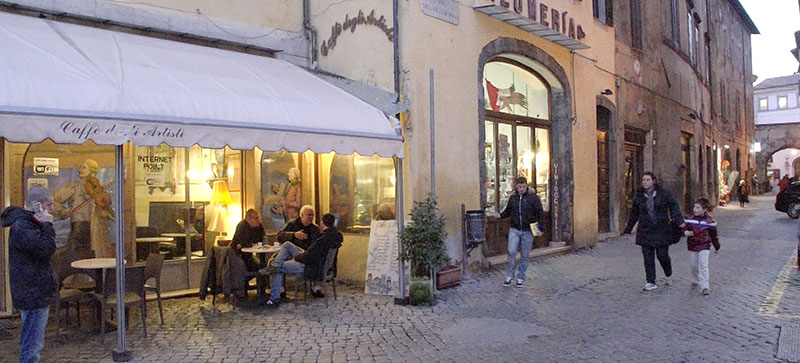
A favorite spot here is Café Degli Artisti. It's a terrific place for a drink, especially the local wine. While Tuscany is famous for its wines, like the Brunellos, Chiantis the super Tuscans, Umbria also produces quality wine. Alternatively, have a beer or a spritz, have a snack, maybe a light lunch, a light meal. The cafe is just a fun place to gather, even if you're not buying anything, so put this café on your list when you get to Spoleto.
Also, try Osteria Del Matto. Somebody on Yelp said "oh my God, if I could eat here every night I would. This was a trip-making spot. Wow, we just loved it." Another fine restaurant is Il Tempio Del Gusto. How about some fresh pasta with truffles, a local specialty. During the day, the piazza usually has lunch trucks out, and in the morning there's a produce market.
One short block east of the fountain you will see the City Hall on Via del Municipal, and the adjacent Roman House, open as a museum with entrance around the corner on Via di Visiale.
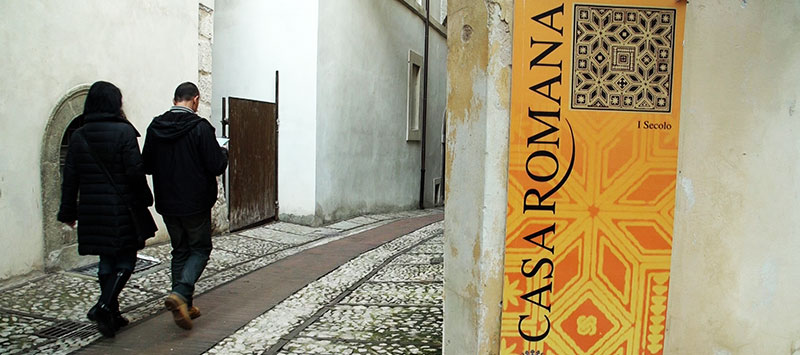
This 2000-year-old Casa Romana house dates to the beginning of the first century, and was discovered by archaeologists in 1885. It is quite amazing to have a Roman house with this quality of preservation still standing.
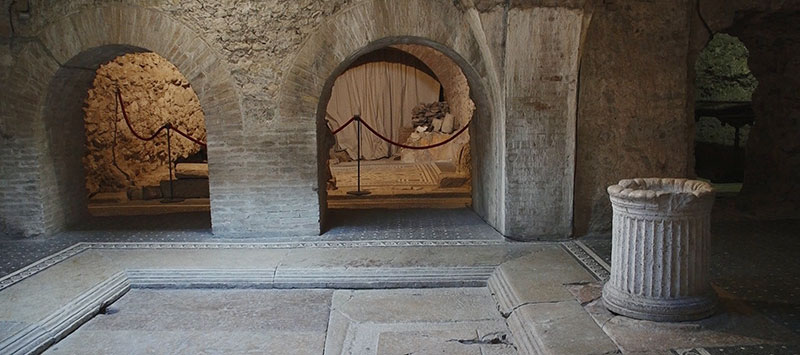
You'll see rooms with barrel-vaulted ceilings made of brick and original floors with mosaic tile patterns. It's believed that this house belong to the mother of the ancient Roman Emperor Vespasian, who built the Coliseum.
The house remained in use continuously all away up through the early medieval period, when it was probably partially destroyed by a fire, and further damaged by some construction in the vicinity. But it has been restored so well you feel like you're walking back 2000 years into an original Roman house.
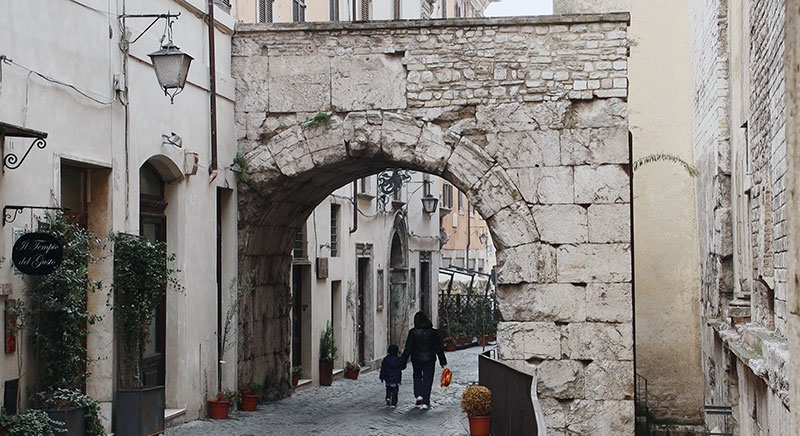
At the south end of the market square there is an ancient Roman arch called the Arch of Druso and Germanico, dating from the year 23 A.D. It's on a busy little street with two-way traffic driving right through it.
Notice the existing street level on the right side and then down below, the original Roman level, with paving. It's a cross-section in time showing how levels rise with dirt coming in and subsequent constructions. The arch was built in honor of the adopted son of the Emperor Tiberius.
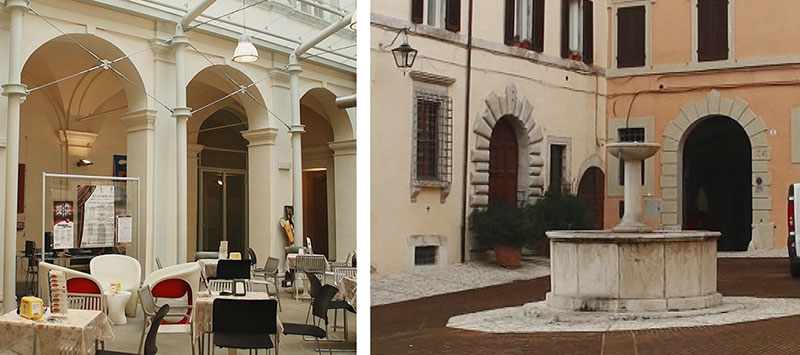
Have a brief look just south of the market square at Piazza Pietro Fontana and Palazzo Mauri, built in the late 1600s, which is now a public library, Municipal Library Giosuè Carducci. It also has the Literary Café, open to the public for food and drinks, where you can see a Roman Mosaic floor down in the basement.
Around the corner there is another major Roman site, the Arch of Monterone, one of the five main gates through the ancient Roman defensive walls. A similar pattern of smaller arches, not part of ancient walls, is found in many Spoleto streets, connecting buildings and stabilizing them.
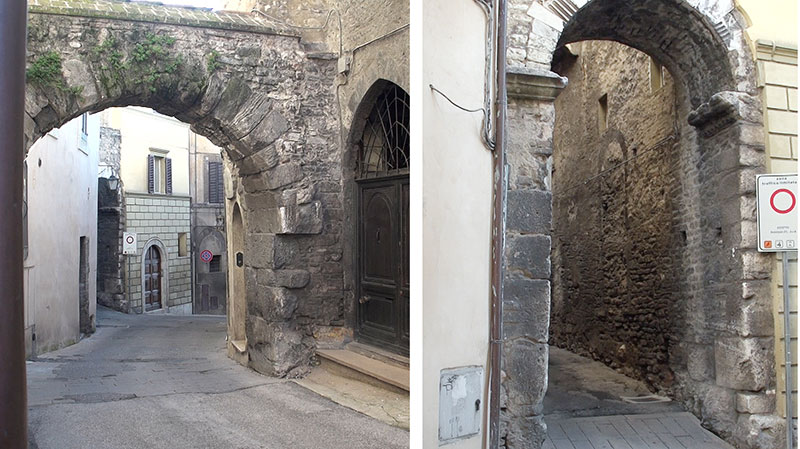
This leads us right to the Via delle Felici which has its own arch leading into the street. It looks like another narrow pedestrian street, but cars can drive right through this little archway, and so can trucks, so watch out for the traffic. Well, these drivers know what they're doing, obviously very experienced in these roads, so they just gun it and speed right along.
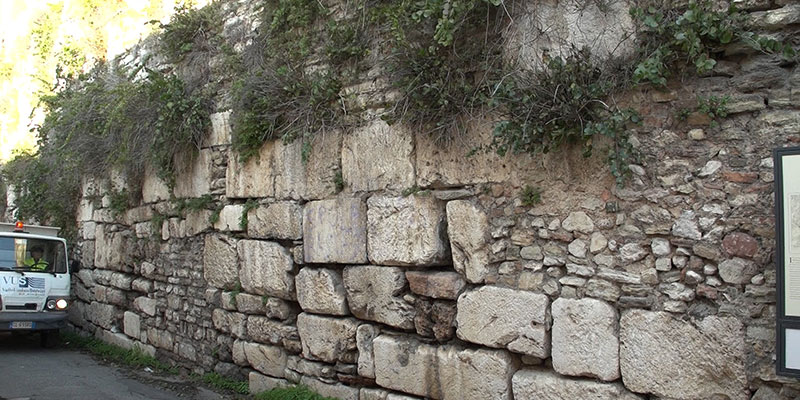
Another section of the massive ancient defensive wall runs alongside Via delle Felici. These were actually built before the Romans by the Umbri, the tribe who settled in this area first and had a thriving culture for many centuries. That's why we call this region Umbria.

Via delle Felici continues on for a few blocks until you see a staircase on your left that you will now climb. Like many of the staircases in this hill town, it's more of a ramp with some steps in it, which makes this easy to climb. Alley staircases like this are so small they sometimes do not appear on maps, so you have to look hard to find them. The steps lead to Via Brignone and then around the bend to a little park.
On Piazza Campello where you'll see the Mascherone Fountain, with burbling drinkable water. You'll probably also see the small cat colony that lives in this piazza, that are being taken care of by some of the neighbors who provide them with food and attention. And there are some benches in this little park, so it's a good place to sit, watch the cats, and rest up after ascending that staircase.
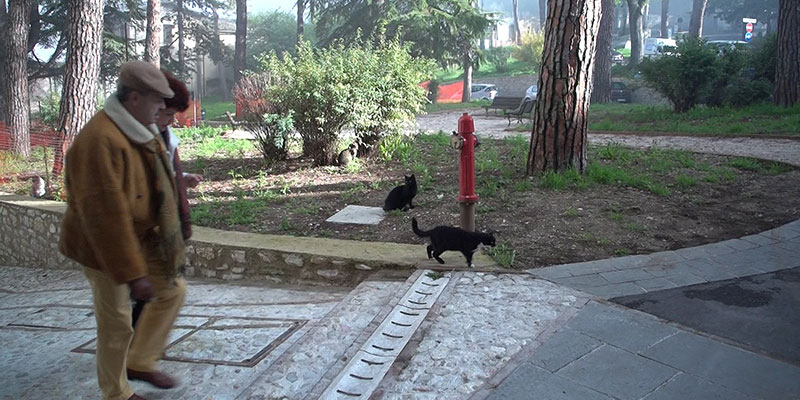
At this point you have a choice regarding two nearby destinations: either visit the fortress (Rocca Albornoziana), followed by the cathedral, or if you are short of time, skip the fortress and just go to the cathedral.
You will find the fortress is well worth visiting, highly-recommended, and will also give you a look at the amazing aqueduct bridge across the valley behind it. The cathedral is just one block away along Via Aurelio Saffi, as we will see after our route continues to the fortress then returns to this Piazza Campello.
Part Two: Fortress and Cathedral
To reach the fortress, leave the piazza and walk 200 meters along Via Matteo Gattaponi, which provides wonderful views across Spoleto and the hillsides beyond.
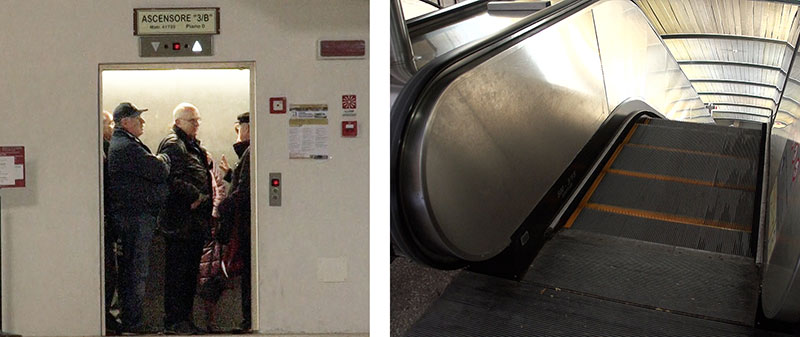
An escalator then takes you up to the fortress, where you ride an elevator for the last leg to the top, very easy!
The fortress was constructed in the 1360s for Pope Innocent the 6th and Pope Urban the 5th, taking tenyears to complete. The popes built it as part of the campaign to retake the papacy from the Avignon Popes. The great Schism was a religious struggle in the mid-14th century, with several different popes in France and Italy competing for power.

This was the largest papal stronghold, built at the highest point of the town. From here you get some views looking down on the town, and to the valley below. The name of the fortress is Rocca Albornoziana, named after a Spanish Cardinal Albernoz, who was sent here by the Pope in the 14th century to construct the castle. He enlisted the services of Gattapone, a famous architect from Umbria who came and built the fortress, and the bridge behind it that we will see shortly.
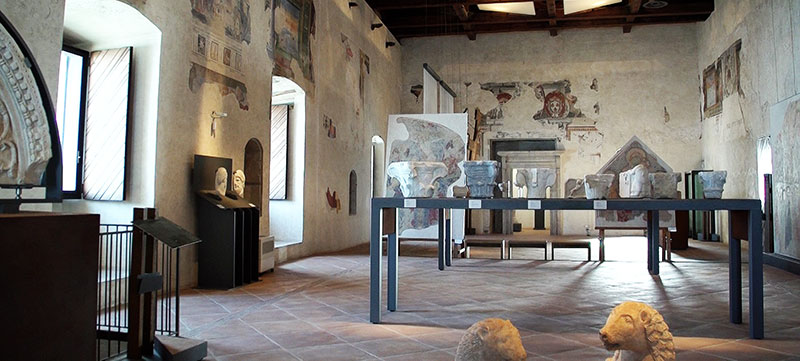
The interior is now a museum, called the National Museum of the Dukes of Spoleto, with many paintings and sculpture and artifacts of the day. You can walk through the 15 halls on both levels. For a while it had been the residence of the duchy, governors of the city, and papal legates, back in the 15th century, 16th-century, and some of the interior displays reflect that period.
Take a look at some of the frescoes and artifacts here, most of which date from the late 14th century to the early 17th century. One Byzantine painting has a shrine on top with some bones of important religious figure, preserved as items of worship that would have hung in a church. Sarcophagi and tombstones and sculpture also illustrate various religious rituals.
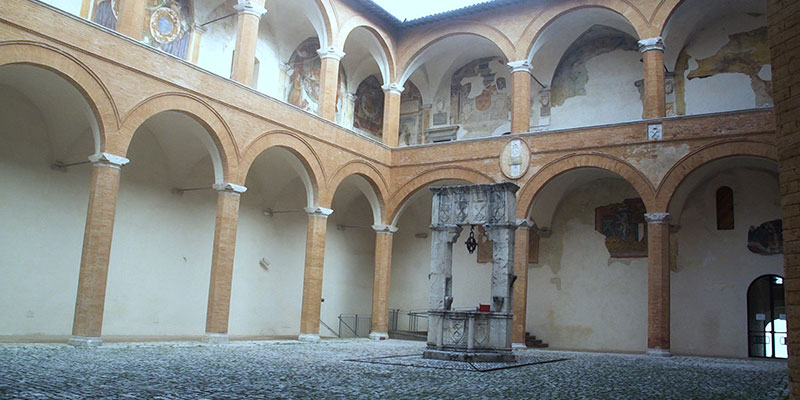
This fortress palace resisted many attacks, and it remained well-preserved for centuries but gradually fell into decay. And then in 1817 it was turned into a prison until 1983. Much of the interior was damaged, but fortunately there was major restorations that brought it back somewhat to its former glory.
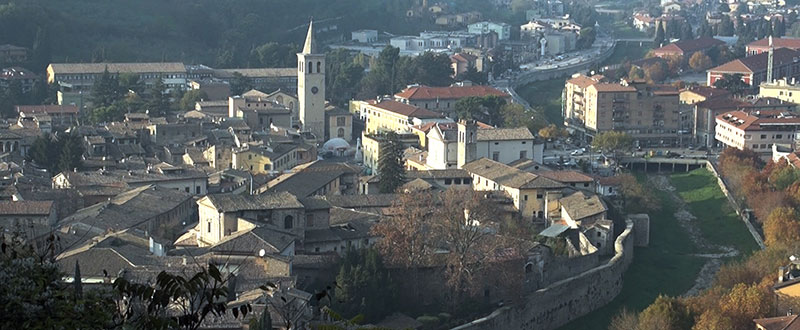
Outside you can see some interesting nearby buildings, along with more views looking down into the city. The grand vista extends all the way to San Gregorio Maggiore, a church we shall visit at the end of our walk. There is a small admission charge to go into the fortress, but it's free to walk around on the outside of it to admire the exterior of these very old structures. Then take a walk on the outside path that goes all the way around the fortress. You go past the castle gateway and walk along the road for about 100 meters. It can get a little misty sometimes up here.
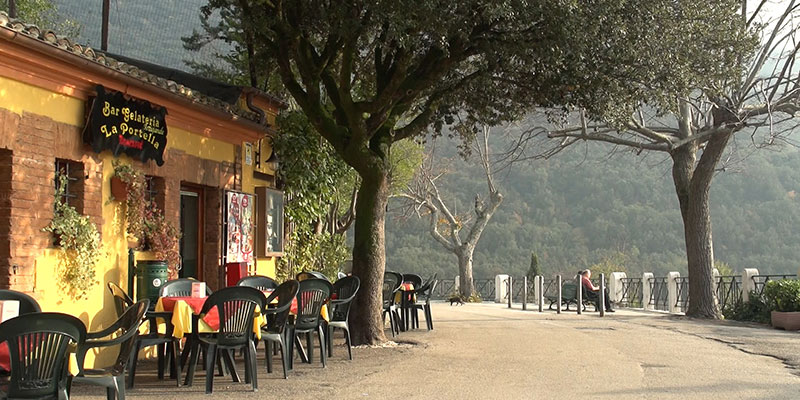
This walk is the famous "giro della Rocca." It goes for one kilometer all the way around the castle, and it's really one of the most charming promenades in town. The walkway is level, and you'll go around the bend and see there's a nice café on the corner with some outdoor tables with a view. Blazing fall colors were still visible during our visit, which was in November.
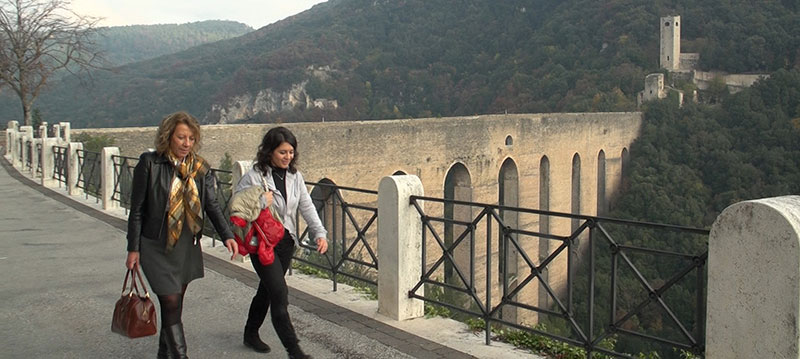
When you walk around the bend you are going to get a view of one of the largest stone constructions of the ancient age, the Ponte delle Torri.
The spectacular view of Ponte delle Torri will be your great reward for taking this walk. It functioned both as a bridge that provided a major access route into Spoleto and was also an aqueduct bringing water from the hill into the city. Ponte delle Torri was built in the 13th century on foundations of an earlier ancient Roman bridge. This medieval bridge is really an incredible engineering feat. It's 80 meters high above the valley floor and the bridge spans 230 meters. It's huge!
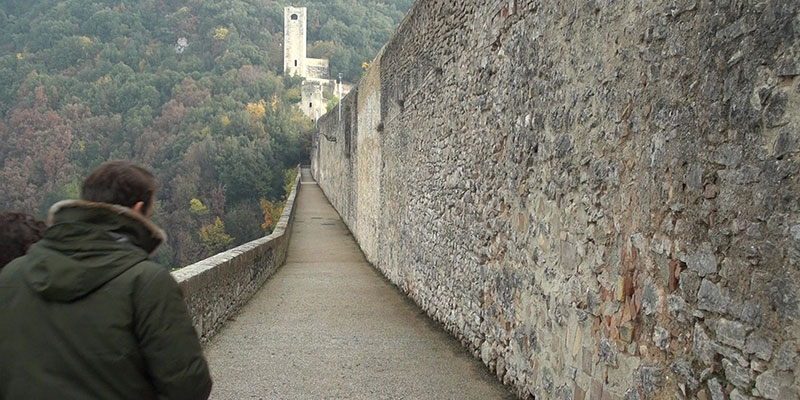
The bridge reaches across the ravine, linking the fortress with the slopes of the Monteluco mountain. On the far and you see the tower of a smaller fortress. Two columns in the middle are hollow inside, with two small windows for what had probably been the rooms of a guardhouse, and those of the tallest columns, reaching down to the stream.
Normally it's possible to walk across the bridge freely, no charge. Unfortunately, a minor earthquake a few years ago destabilized the bridge, so pedestrians are no longer allowed. Repairs are delayed, and they are hoping that it might reopen by the year 2025. But now you can still enjoy the views of the outside of the bridge. Perhaps by the time you get there it will be open.
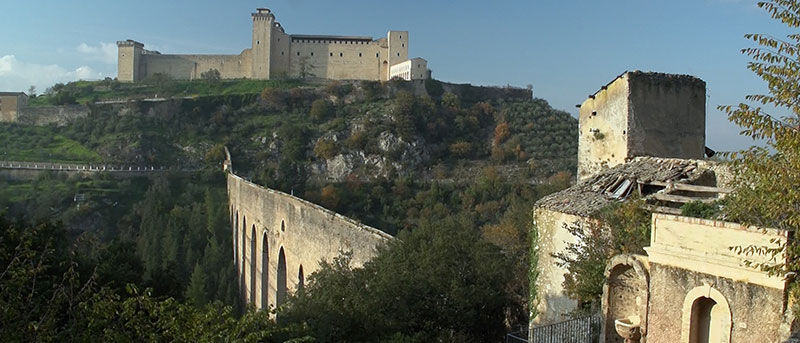
The view looking back from Monteluco hill is most spectacular, with the bridge in the foreground and the fortress rising up on the hill behind. In addition to appreciating the grandeur of Ponte delle Torri, you will enjoy the beautiful countryside all around it. You'll see thousands of olive trees covering the hillside, and some hiking trails you can take on the other side of Monteluco.
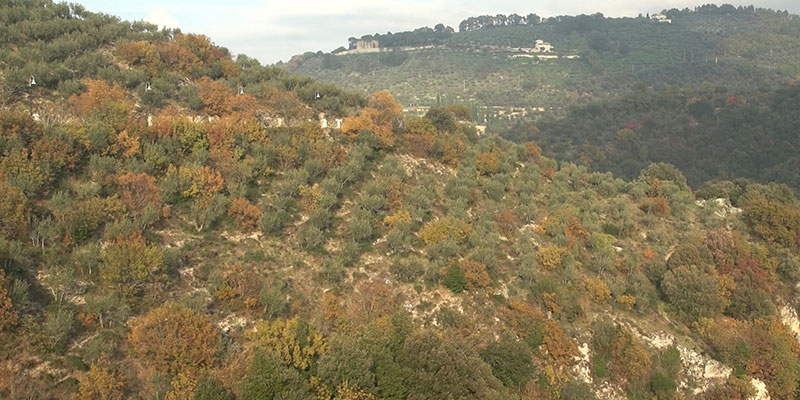
When you come back around in front of the fortress, you'll get more of those beautiful views looking down at the city. You could go back downhill the same way, using those escalators if you like, but it is shorter to walk directly from the fortress to the our next big destination, the Cathedral.
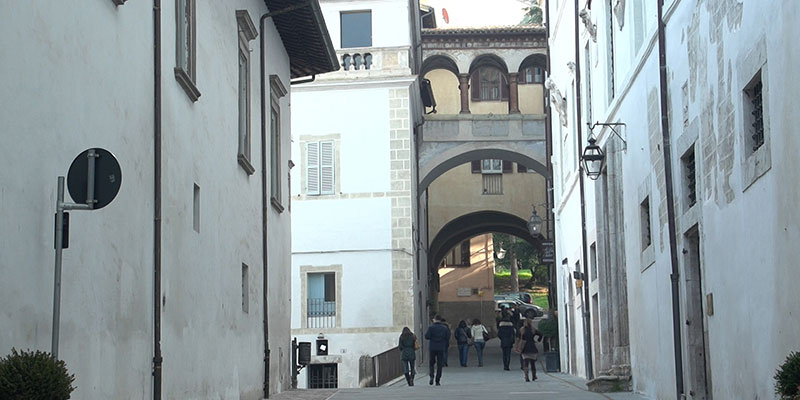
Continue from that Piazza Campello seen earlier to the adjacent Via Aurelio Saffi, which has several arches across it, including one with a medieval loggia at the top. This street is almost like a little piazza, quite level, wide, and contained at both ends by beautiful arched buildings.
One of the reasons for these picturesque arches was so they could build a house on top of the street, probably connecting two houses on opposite sides of the street, so it's functional and beautiful. It leads to the main attraction of town for many people, the cathedral.
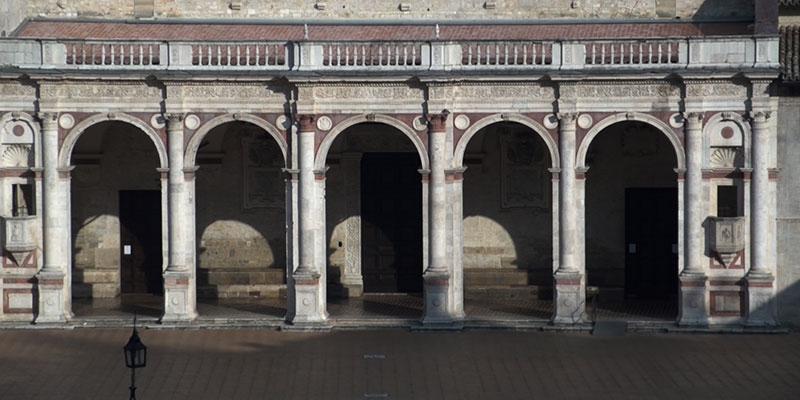
Turning from Via Aurelio Saffi down the staircase street of Via dell’Arringo which leads to the Duomo. Built in the Romanesque style between 1175 and 1227, it is called the Duomo of Santa Maria Assunta, .
The interior evolved over the centuries with a mix of Renaissance and Baroque styles, with many important works of art, featuring sculpture, painting and beautiful architectural details.
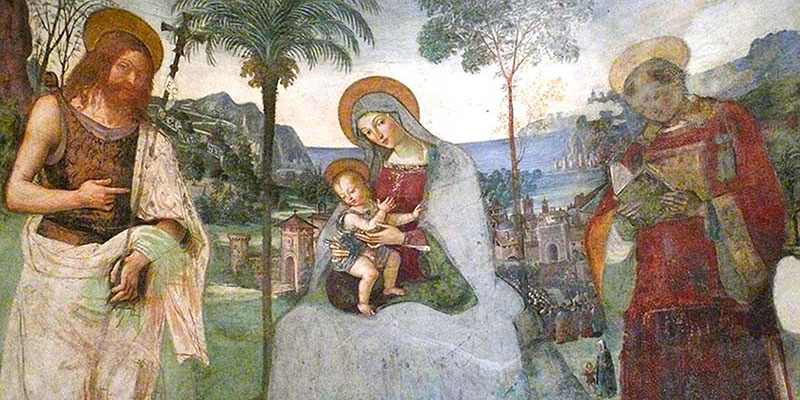
Behind the altar are the most important paintings in all of Spoleto, featuring stories of the Virgin. Her coronation, the Annunciation, Nativity scene, and the Death of the Virgin. It's the final masterpiece of Filippo Lippi, who died here while painting these frescoes – buried here in a tomb designed by his son Filippino Lippi. Pinturicchio painted the Madonna and Child with Saints, and many other artists are represented here, such as a Annibale Carracci and Bernini.
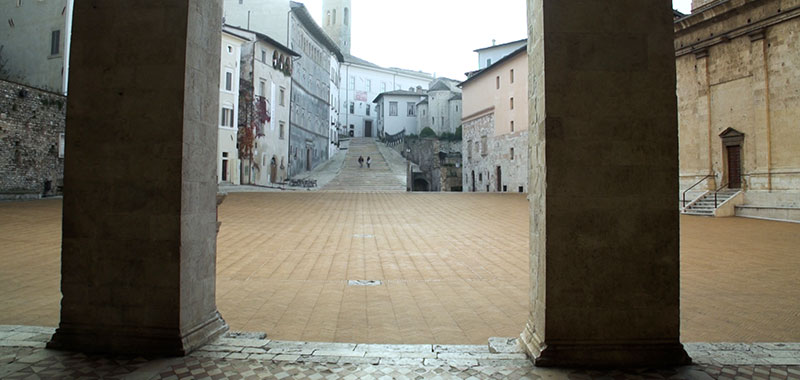
The Cathedral's front porch or portico features a geometric tile floor and sturdy columns, offering a sweeping view up the big staircase leading to the piazza. The façade includes statues of bees, the symbol of the Barberinis, the noble family who promoted the renovation of the Duomo in the 17th century. Next to the Cathedral is an attached ecclesiastical building with two levels of loggia.
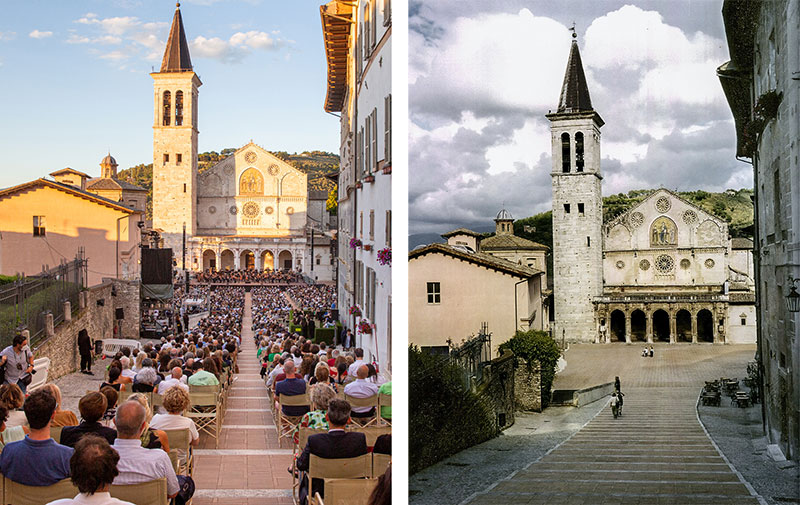
The grand piazza out front is sometimes a setting for major outdoor concerts, especially during the annual Festival dei Due Mondi. During the festival the piazza is filled with thousands of chairs for the large audience, but other times the same piazza can be quite empty.
Rather than walking back up that steep staircase, Via dell' Arringo, exit to the right of those steps on Via del Duomo, which will lead into more fascinating little lanes to explore. Note that there is also an escalator here that could bring you down to the Ponzianina parking lot, if you are parked there and ready to leave, but we have more walking to do.
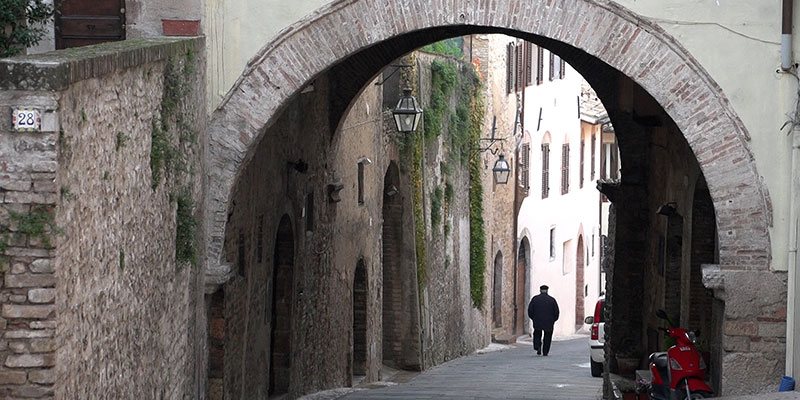
Via del Duomo goes under a few arches and brings you to Piazza Della Signoria, which provides a lovely view of the town below. In one more block there is another staircase street, Via dello Spagna, narrow and steep. The street then levels off, and we continue along for a few blocks and then back to Via del Duomo.
The 2-star Hotel Panciolle has an excellent location in the old town. It has just got 7 rooms, and a restaurant, and a terrace with a view. You could reach the hotel by taxi from the train station or drive there in your own car.

A charming mini-park with a fountain is next to the hotel at Largo Muzio Clementi. This little neighborhood is ripe for exploring little back lanes, such as Via dello Spagna, which veers off from Via del Duomo as a staircase street then levels off.
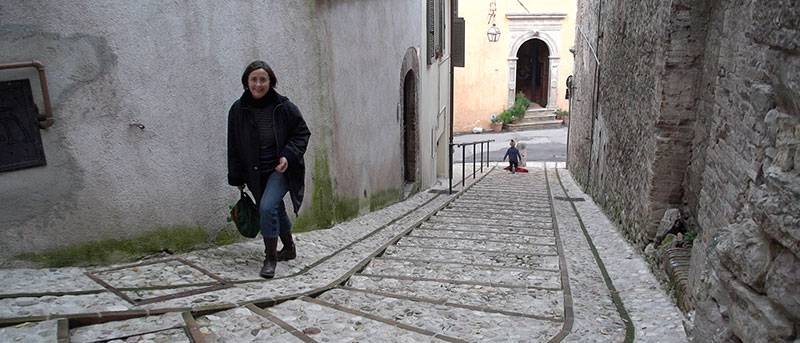
We've just got a few more streets to see in our walking tour of upper Spoleto, as we continue on Via del Duomo, then turn right to Via Filitteria. (Alternatively, you could continue on Via del Duomo, which changes names to Via Tobago, to the Church of San Filippo Neri, then rejoin the main route a block away at Menotti Theater.)
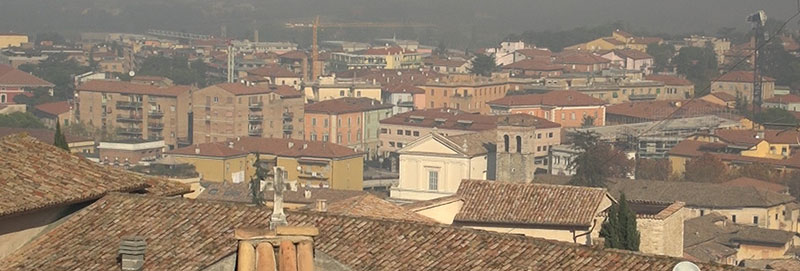
Walk around the curve in Via Filitteria and go over to the side where you get another nice view looking out across the city, down into the newer part of town. Via Filitteria is a busy street with buses rolling by, and there is a nice tea room here, Tebro. There are always little side streets that are intriguing to have a look down, such as Via Minervio on one side of Via Filitteria, and its staircase extension on the lower side, Via Salara Vecchia, which we shall descend in a moment after another detour to see the theater.
One block further along Via Filitteria brings us to the town's main theater for orchestra and opera, Teatro Nuovo Gian Carlo Menotti, built in the neoclassical style of the mid-19th century. Located on Largo B. Gigli, the theater is named after the composer Gian Carlo Menotti, who founded the famous music Festival of Two Worlds, (Festival dei Due Mondi) in Spoleto, in 1958.
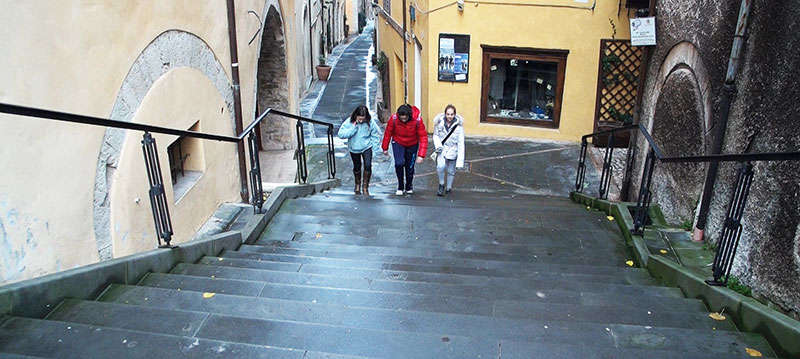
Return one block to those alluring steps leading down to Via Salara Vecchia, another lovely pedestrian street. This will take you to Piazza Torre Del Olio, named for that great tower looming over the city. About 100 towers were here previously, and this one is tallest of the few remaining.
In medieval Italy, towers were the skyscrapers of the day. They were a way of defending the household against attack from outsiders or bandits and symbolized the owners' great wealth and strength
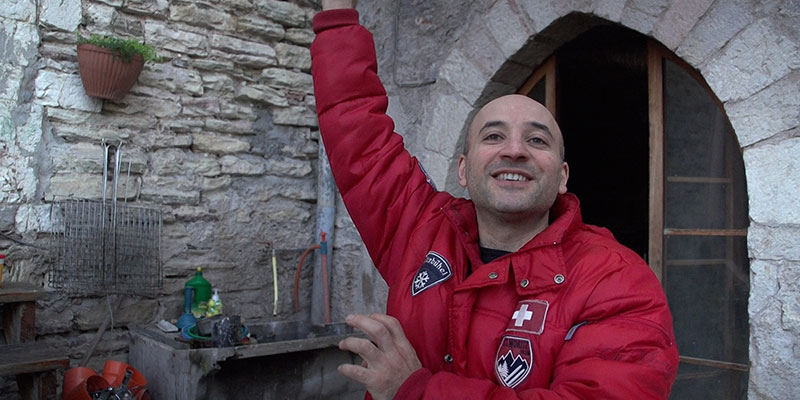
I happen to meet a friendly local guy who lives and works in a shorter, 800-year-old tower. "The tower of my father. My father rebuilt it. This is original.This is Gothic. More height, more power. I'm a third-generation carpenter, still working on it."
We have reached the last leg of our walk through upper Spoleto, heading down Via Porta Fuga, which has an amazing tale to tell. It was the salvation of ancient Western civilization. What!
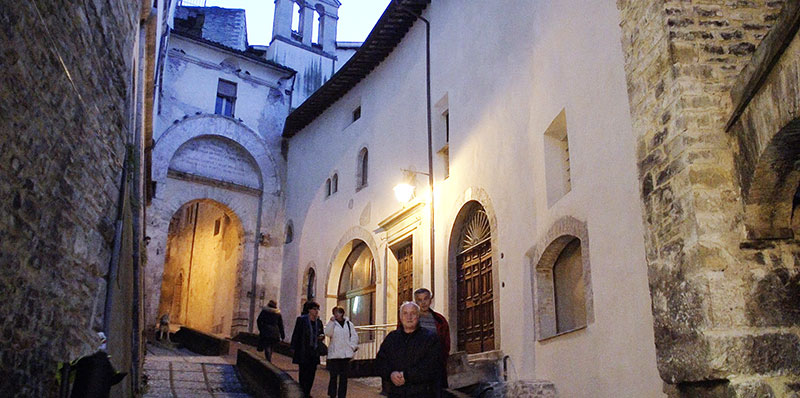
Remember Hannibal? Crossing the Alps with those elephants and trying to attack Rome in 217 BC? His invasion of Italy got only as far as this point in Spoleto, with the Roman gate and defenses that defeated him, pushed him back, prevented him from attacking Rome, and preserved the foundation of Western civilization. Otherwise, we might all be speaking Carthaginian.
Via Porta Fuga leads directly into the lower town, where it changes name to Corso Giuseppe Garibaldi, the main pedestrian street of Spoleto. You will want to spend some quality time, taking a stroll along this grand promenade back and forth, during the day and into the evening. It is a fine place for people watching, shopping, and eating, functioning like the outdoor living room of Spoleto.
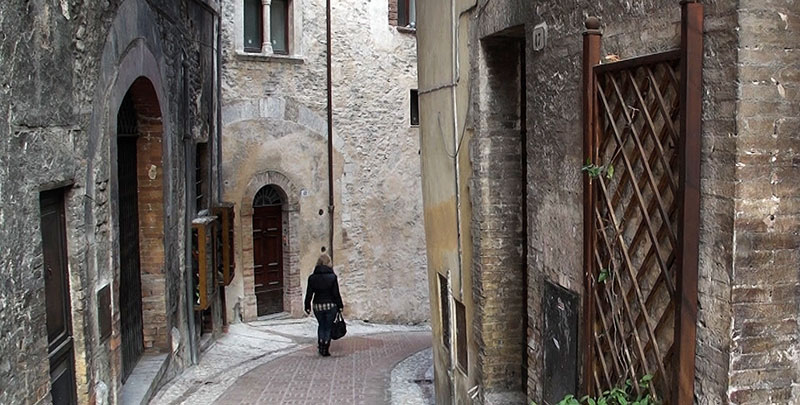
A perfect time to walk this lane is early evening when many locals come to stroll in the traditional passeggiata, the Italian parade of people just walking along at a leisurely pace, doing a little window shopping. It's a big pastime in Italy. Come on out, dress up, see your friends, say hello, stop and chat for the latest news.
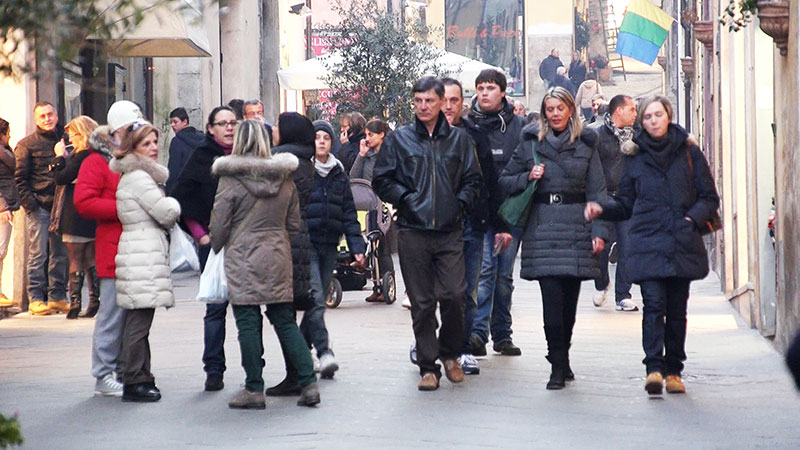
People of all ages take part in this sociable performance, from the youngest babies in their strollers, to the oldest members of the community, some of whom just take it in from the sidelines. Even when walking along the main lane at a peak time of day, while there are plenty of people out strolling, there do not seem to be many other tourists here, except for me, who's taking the pictures.
All too often, we fly through our lives as if there is no tomorrow, in some kind of supersonic speed, but here in Italy, in the evening during passeggiata, people are not in a hurry, they just slow down and relax. It's a fun way to fill some time after work and before dinner. And while some snack shops and pizzerias are open this early, it's not really a time for dinner yet – that comes afterwards.
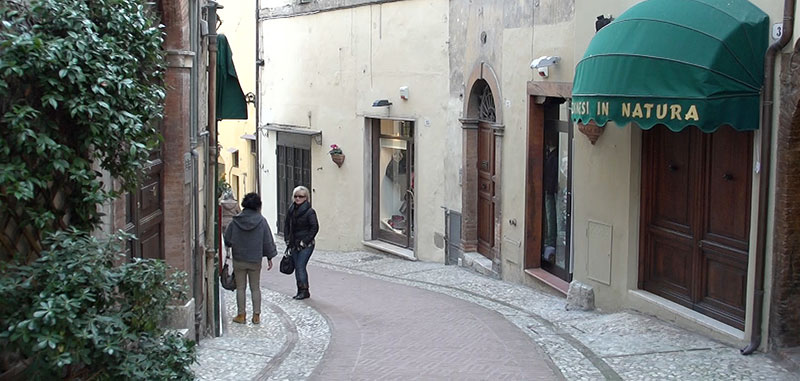
Store hours can be a little mysterious for the foreign visitor, who might want to do some mid-day shopping to find out that most of the stores are closed, closed for siesta and lunch, then they reopen and generally stay open until about 8 PM.
I saw a wonderful example on the Corso of locals getting together for a bit of sport and socializing, using one of the side lanes as a football pitch. One of the side lanes off the Corso, Via dei Gesuiti, is blocked off from traffic so the kids can get a few football games going on miniature play areas.
The game is most unusual, called "Tennis football, calcio tennis." They are playing tennis with a soccer ball, using their feet and heads to get the ball over the net. It's a real family activity with the parents sitting around having a good time, clowning around a little bit.
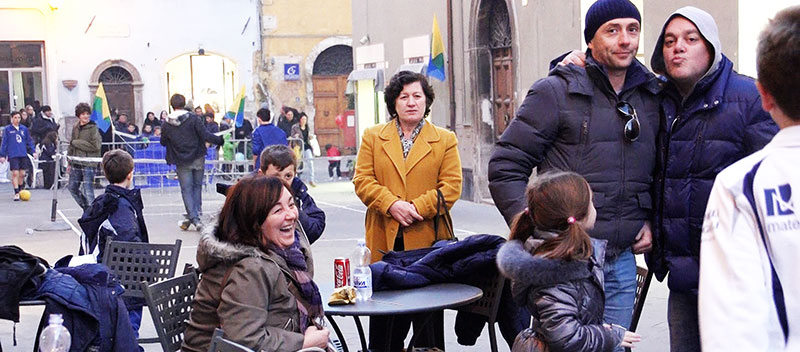
They just take over the café tables and the street, turning it into their playground and outdoor living room. These people live in the general neighborhood of the old town, where there are not many park areas or green fields for playing soccer, so they make the most of it by turning the street into a ball-field.
Meanwhile back on Corso Garibaldi, the passeggiata continues. People gather in bigger numbers as it gets a bit later, multi-generations out together. Even the dogs have a chance to say hello. You'll notice that the main goal of this evening ritual is not trying to get from one place to another. It's just to go and have a chat, take a walk, get out of your small apartment and say hello to your friends.
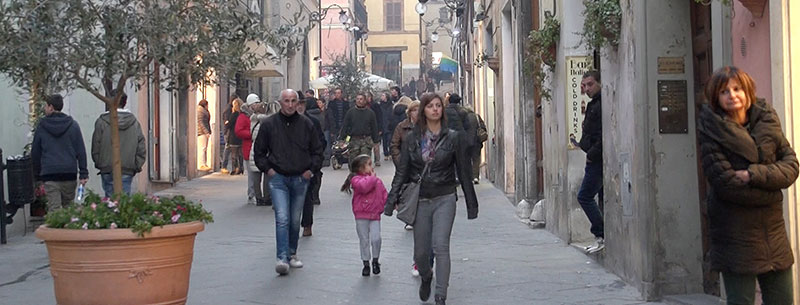
For the locals this is just another day, but for the visitor who is paying attention, it is really something quite remarkable that you might not find back in your own hometown. Various conditions helpfully come together to make this ritual possible, such as having an extensive pedestrian zone and a main pedestrian lane, and a community that lives in fairly close proximity to the center of town, the kind of place where people get to know each other.
People living in the smaller Italian hilltowns do a lot of walking to get around, which also promotes social interaction. The streets are largely for pedestrians rather than driving a car, as many people do in the west. And while this walking is not a vigorous exercise, it is a healthy way to get around. And then walking up and down the inclined streets adds another dimension to the benefits.
Now we are heading towards some final monuments, walking to the end of Corso Garibaldi, then turning along Via dell' Anfiteatro to the old medieval wall that still goes around this part of the town. It protected the town from attack, and flooding of the nearby river. Its massive size shows this was a fortified wall, with slits in it for firing out with cross bows to repel the enemy in those perilous days of the Middle Ages.
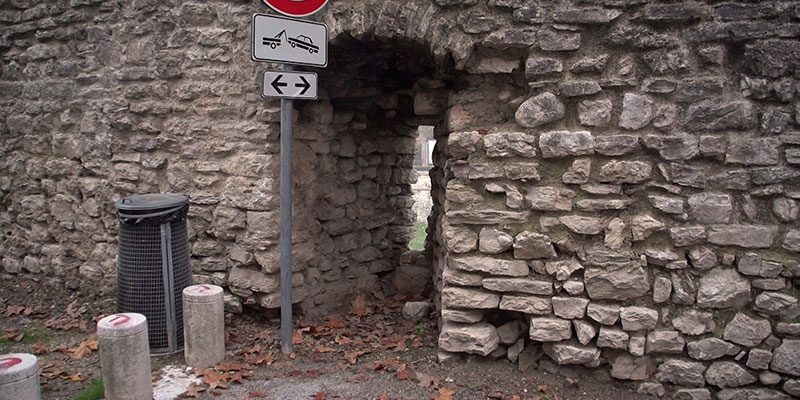
Even more amazing here are the remains of the ancient Roman amphitheater, which dates back to the 2nd century A.D. The oval structure is a smaller version of the Roman Coliseum. Not open to the public, it has not yet been restored.
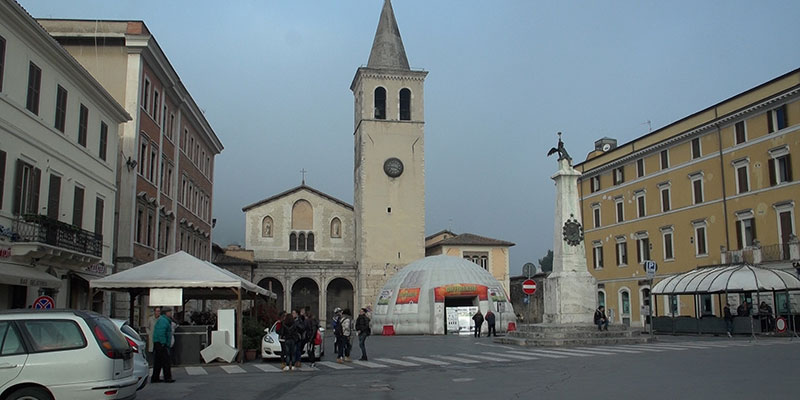
This end of Corso Garibaldi has one of Spoleto's most important churches, San Gregorio Maggiore. Originally built in the Romanesque style during the 11th and 12th centuries, and renovated in the 16th and 18th centuries, but still reflects the influence of the Longobard Romanesque architecture. There is an impressive series of frescoes along the wall on the left aisle depicting the Madonna and Child with several saints, created in the 14th century. Three arches form the portico of the 16th century façade.
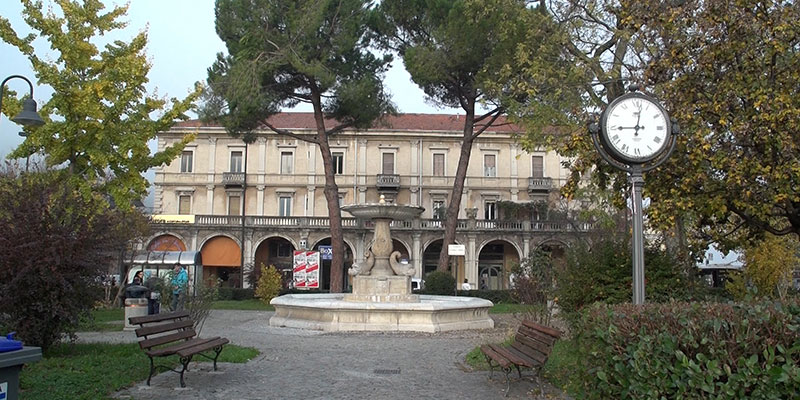
The church is next to Piazza Della Vittoria, which is the gateway to the old town. There is a small park with fountains and benches, a loggia nearby, some hotels and shops around it.
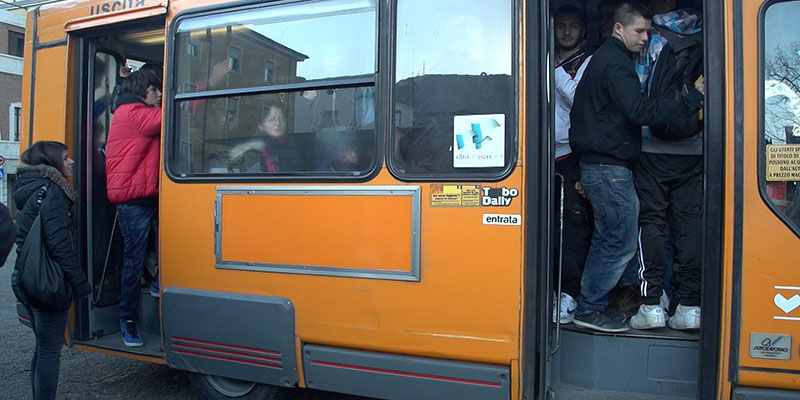
From Piazza Della Vittoria you could get to the train station, one kilometer along Viale Trento e Trieste, on foot, in a bus or by taxi. Better yet, spend the night in Spoleto and have another day to wander more in these divine lanes.
We have been exploring the real Spoleto, getting beyond the tourist monuments of the churches and museums, which are practically the only sites you'll read about in a typical guidebook. In fact it is hard to find a guidebook that has a lot of useful information about Spoleto. The Umbria guidebooks might have a few pages that cover the churches, museums, restaurants and hotels. But they really don't tell you much about where to walk when you're here, and what to see.
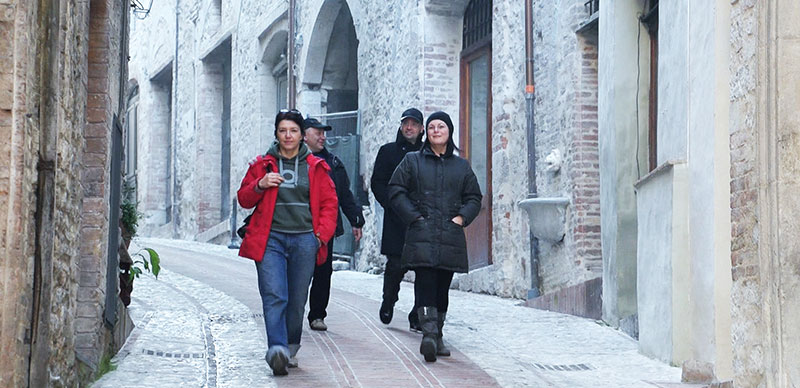
In this article we have described how you can navigate the staircases, ramps, steps, and inclined streets that you have to deal with when you're walking around, because this is a hill town. This kind of walking shows you the authentic aspect of a place, and brings you in contact with the locals.
On the other hand, many tourists avoid this by taking the city's escalators. Three separate routes of these escalators and travelators, mostly underground, will bring you up the hill. With that, you can bypass most of the streets that we've been walking on, which is great for those who have little time or energy. But for the rest of us, that mechanical shortcut removes the direct, genuine contact with the city itself, which is a shame because one of the great joys of exploring a hill town in Umbria is just wandering the little lanes, maybe getting lost, perhaps meeting some locals. It's all part of the adventure.
That completes our walking tour of Spoleto.